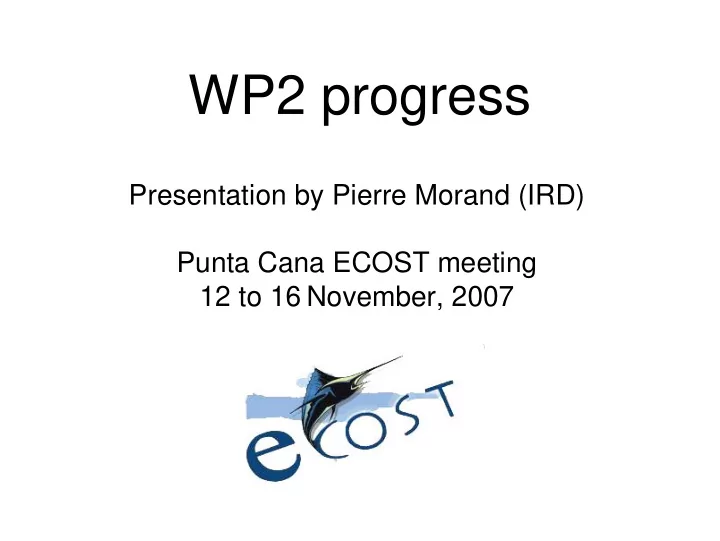

WP2 progress Presentation by Pierre Morand (IRD) Punta Cana ECOST meeting 12 to 16 November, 2007
Remembering of the WP2 components • WP2.0: data use agreement document (PM and PF) • WP2.1 & WP2.4: construction of information & setting up a server for collection and arrangement of information (= the « information platform » stricto sensu ) (CC and PM) • WP2.2: model of (resources x activities) interactions (FL) • WP2.3: GIS (Guinea Bissau and MG) • (in addition : support to WP0 for the portal server setting up and maintenance) (CC and PF)
Advances on the WP2.1 & WP2.4 « the platform component » • Support to WP3a : setting up a web tool for registering data of the « job satisfaction survey » • Development of a web data base tool to collate the data for the SAM matrix (economic part of the ECOST model)
A web tool for registering data of the « job satisfaction survey » • A preliminary step : an Access data base structure with an interface (sent to the WP3a team on June, 2007) • A final step: a web data base interface (currently on the portal)
A .mdb file, inlcuding a « formulaire » to help at filling it Tested in Senegal by Aliou Sall, before the Amsterdam meeting (early July)
A web tool for registering data of the « job satisfaction survey » • A preliminary step : access data base format with a an interface (sent to the WP3a team on June, 2007) • A final step: the web data base interface (currently on the portal)
Advances on the WP2.1 & WP2.4 (the « platform component ») • Support to WP3a : setting up a web tool for registering data of the « job satisfaction survey » • Development of a web data base tool to collate the data for the SAM matrix (economic part of the ECOST model)
First step: to analyze the structure of the data requirement (the SAM matrix, available from August, 30th, 2007)
A dimension or a variable or a criterion A dimension or a variable or a criterion The nomenclature for this given criterion The data (called also the statistics)
Remarks and comments • The 12 variables/criterions have the same definitions for all of the ecoregional partners. When these criterions are crossed together, it leads to 23 relevant tables of statistical data (not 144 !): the SAM matrix. • For a given table, most of the data cells will be filled with a zero value. • For a given griterion, some elements of the nomenclature may differ from one partner to another one. • The time dimension (i.e. the successive years) should constitute an additional variable/criterion, which comes across all of the 12 previous variables/criterions : it is the « depth » of the SAM matrix. • For a given partner, the nomenclature of the time is the list of the years for which some data are available. • Moreover, the expression of the data or statistics (inside the cells) may vary from a partner to another one (for example: difference of the units used) We have developped a tool to manage all these specificities
A web data base tool to collate the data for the SAM matrix : the prototype
A branch of the explorer leads to the view and management of nomenclatures It allow to define the list of variables/criteria which will be relevant : Ex.: n= 12 for the SAM model
For a given criteria/variable, each of the country/ecoregional partner may have a specific nomenclature
Fo example, one can customize or update the list of items inside the « commodities nomenclature » for Senegal
The secund branch of the explorer leads to manage data Data are organized by containers. The list of containers may be managed. One can also define subcontainers.
Example: definition of a subcontainer
At the finest level: defining a table inside a given container A table is defined by one, two or three criterias/variables, and by one statistic. Ex.: 23 tables have to be defined inside the subcontainer SAM
Potential efficiency of the web data base tool • Providing help to everyone for the registration of data in a normalised and convenient structure • Making the data available for requests, for modelling, with many possibilities (agregation/desagregation) • The data structure is easy to explore and to manage (to adapt for specificities of each country)
Current situation and problems The prototype of the web data base tool designed to collate with the statistics is nearly achieved, but not actualy operational. C. Compaoré (the computer engineer who has developed this tool) has just left our IRD office (for a new and better position at African Union Commission). IRD-Osiris can achieve this tool but not within a short delay. Basically, most of problems of the data collating process for the SAM matrix may be addressed using EXCEL or ACCESS, including the nomenclatures management. We remember that the web data base tool option is the preference of the project coordinator, based both on « good » (contractual commitment, data structure reliability, generic tool) and maybe « bad » justifications (fashion trends). What is the real degree of emergency for collating data ? How can we proceed on this ?
Recommend
More recommend